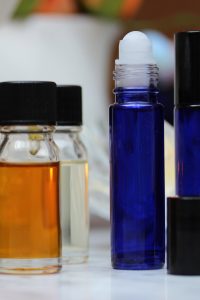- info@aromantique.co.uk
- 07419 777 451
Heather Dawn: Godfrey. P.G.C.E., B.Sc. (Joint Hon)
A synopsis of the outcome of a small pilot study conducted at the University of Salford in 2010, exploring the use of essential oils (without massage) for stress and related conditions.
Heather Dawn Godfrey PGCE, BSc., FIFA, MFHT
General Background
This small-scale study involved six participants (subjects) and two therapists. Each participant attended five consecutive appointments over a one-month period (two of these appointments were conducted as telephone interviews). All participants presented with symptoms of stress or stress related conditions, such as, for example, insomnia.
 10 ml blue glass roller bottles were used to deliver a single essential oil or a blend of essential oils (a total of 6 to 8 drops) infused in jojoba oil; self-applied by the participants to their wrist as and when required.
10 ml blue glass roller bottles were used to deliver a single essential oil or a blend of essential oils (a total of 6 to 8 drops) infused in jojoba oil; self-applied by the participants to their wrist as and when required.
If a blend needed replenishing during the course of treatment, a fresh blend of essential oils and jojoba oil was prepared in a clean roller bottle (bottles are recyclable); blends or bottles were not ‘topped up’ for extended use.
Participants were encouraged to keep a treatment diary in order to score how they rated their symptom(s) (initially identified during pre-treatment consultation) after applying the essential oil blend; a simple numerical measurement scale, or range, was used – 1 (no difference) to 10 (completely cleared). Participants were also required to make notes too, thus providing further subjective insight and information.
Outcome
All participants completed the exercise.
One participant rated her symptom (insomnia) improvement at 4, and commented, “slept well last night, feel calmer than usual”. Then, commenting four days later, “had a dream!!!, feel like I haven’t had one for months”. The essential oils used in this participants blend were eucalyptus (Eucalyotus radiata), black pepper (Piper nigrum), chamomile Roman (Chamaemelum nobilis) and rose Otto (Rosa centifolia).
Another participant rated her symptom (insomnia) improvement at 7 initially, going down to 4, then up to 5, but did not comment otherwise. The essential oils used in this participants blend were bergamot (Citrus bergamia), chamomile Roman (Chamaemelum noblis), Melissa (Melissa officinalis), sandalwood (Santalum album).
Both participants above presented with similar symptoms but selected a different blend of essential oils, however, chamomile Roman featured in both blends.
Another participant rated her symptom (low mood due to bereavement) improvement initially at 5, later at 7, then later again at 8, commenting, “using roll-on at 3 hourly intervals (when mood occurs), mood passing quickly as a result”. Then a week later, “using roll-on as and when required, benefits of roll-on are very good”. Then two weeks later, “roll-on continues to be effective, feel calm and unflustered in stressful situations. Coping better with other peoples stresses.” The essential oils used in this participants blend were Clary sage (Salvia sclarea L.), Geranium (Pelargonium graveolens), Jasmine (Jasmine officinalis) and Sandalwood (Santalum spicatum R.Br.).
Participants applied and used the essential oils independently during their day-to-day life.
Apart from consultation, the therapist did not intervene; the participant took their personalised blend away with them to use as and when they required.
All participants responded positively to varying degrees. The fact each participant proactively participated in selection of essential oils to create an agreeable personalised blend potentially influenced this positive outcome.
The outcome of this small study demonstrates that essential oils may have a beneficial influence on mood and emotion in a way that supports reduction of the symptoms of stress and stress related conditions.
Further study involving a larger group of participants will reliably test this outcome. A specific group of essential oil representing those most commonly selected during the initial studies could then be applied to limit variables, and hone tested outcomes more specifically.
Note: During this study, participants appeared relaxed and animated when given ‘therapeutic space’ and permission to reflect. The therapist’s skill lies not just in listening and prescribing appropriately, but also in being able hold and manage the therapeutic space appropriately to create a sense of safeness. Maintaining clear professional boundaries is a significant aspect of managing, and also, paradoxically, liberating positive interaction, which do doubt also served to influence the positive outcome above.
